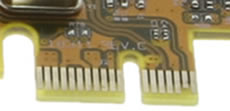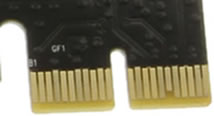USB 3.0 PCI card interfaces allow for upgrades or expansion of your current system. They are manufactured to many different specifications including USB 3.1 to incorporate reversible Type-C connectors, USB 3.0 Type-A to accept multiple inputs for USB 3.0 super-speed devices, and USB 2.0 specifications.
The USB card is an extension of the PCI bus allowing configurations that provide for a more efficient use of a system’s 32 or 64-bit expansion capability.
PCI Card X1 or X2 difference
When you see the X1 or X2 designations in the USB PCI card description, it is referring to the contact configuration to the PCI slot connection. The PCIe USB card contact configuration, the X1 shows a bus connection tab with a single lane, and X2 configuration is slightly different with 2 lanes, see the images below for an illustration.
 |
 |
| PCIe X1 card visually has both a narrow and wide contact area for the PCI slot and is referred to as a single lane, generally preferable because it does not use as much bandwidth. | The PCIe X2 visually has two wide contact points for connection to the PCI slot. This is referred to as 2 lanes. |
USB 3.0 PCI card drivers
The PCI USB 3.0 card may or may not need drivers depending upon the operating system you are running, when you purchase your USB 3.0 card it may or may not include a driver disk, because of this you may need to allow your computer to search for the driver if needed during the installation before incorporating your devices into it. Once any needed drivers are installed, you should be good to go! Please keep in mind if using a USB 3.0 card or USB 3.1 card that your system’s motherboard still needs to be compatible for any driver that may need to be installed for speed considerations.
USB 3 PCI card speed factor
The user may need speed out of the USB card and there is a big difference between a USB 3.0 PCI card and a USB 2.0 PCI card. USB 2.0 only provides a maximum data rate of up to 480Mbps via its USB port connection and this is normal as it applies to the USB 2.0 specification. A USB 3.0 card is a generation1 PCI card that gives you up to 5Gbps of data transfer which is an enormous improvement. Even more so is the USB 3.1 PCI card, this card supports USB 3.0 functionality because of its backward compatibility but offers up to 10Gbps data rate in the generation2 version of the USB 3.1 specification.
USB 3 PCI Card Summary
This article has briefly talked about USB 3.0 cards as they pertain to specification, driver installation, differences between X1 and X2, and speed capabilities, but to recap the card specifications, we have mentioned USB 2.0 high speed card at 480Mbps, USB 3.0 cards Super-Speed at 5Gbps, and USB 3.1 cards generation1 and 2 with backward capability to USB 3.0 but capable of Super-Speed plus at 10Gbps data speeds. As always out technical support team can be contacted for any help needed. Follow this link to our USB 3.0 card and USB 2.0 card products.
